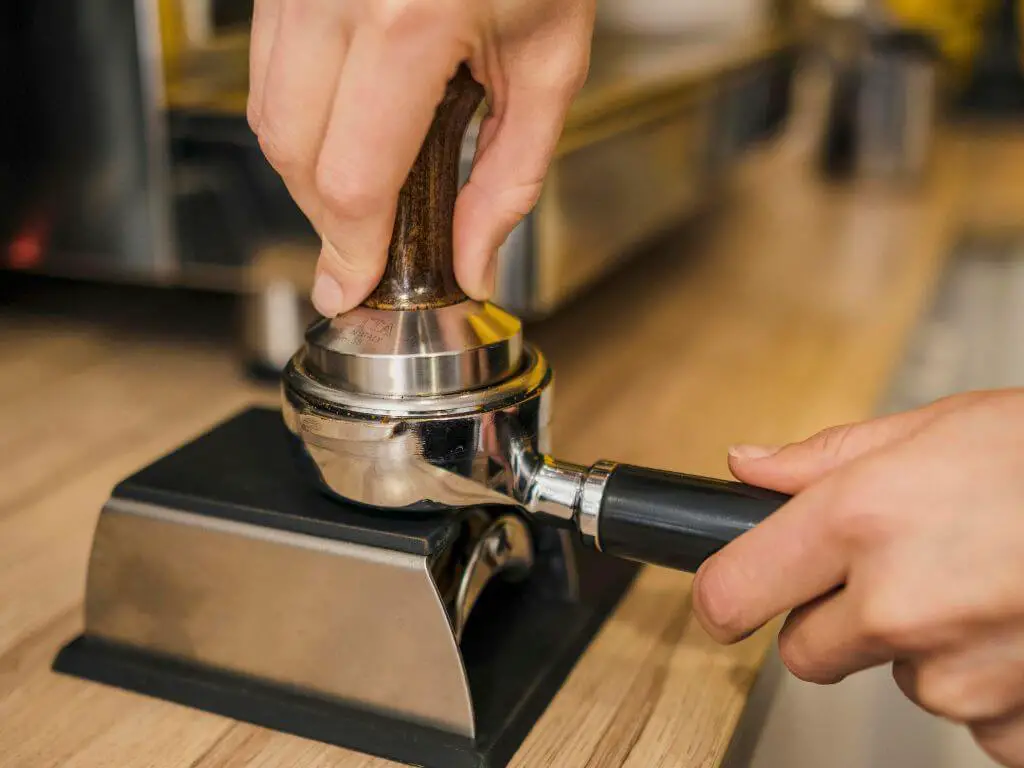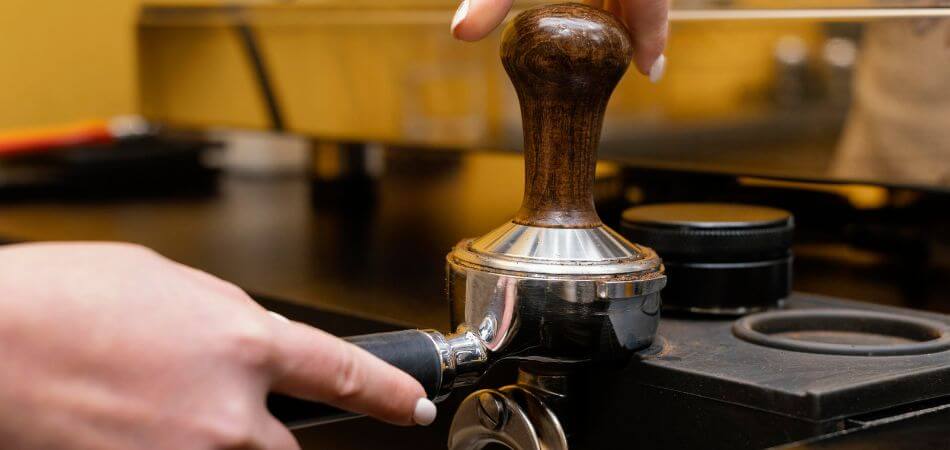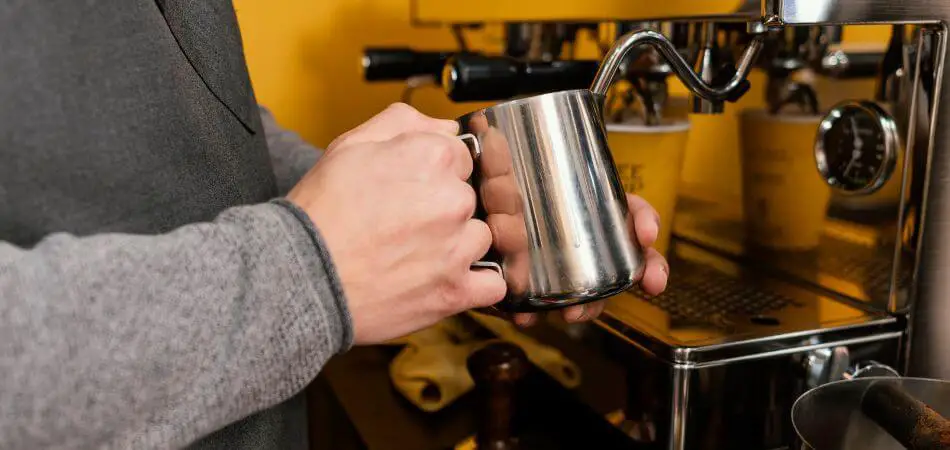Coffee Maker Hot Plate Peeling? Don’t Replace It! Easy Fix Here!

Coffee maker hot plate peeling on your coffee maker is a common issue and can be easily resolved. Here’s how.
A coffee maker is a popular kitchen appliance used to brew coffee quickly and conveniently. However, sometimes the hot plate on the coffee maker may start peeling, causing concern for users. The peeling of the hot plate can affect the appearance and functionality of the coffee maker.
If you are faced with this issue, there are a few steps you can take to resolve it. We will explore the reasons behind the peeling of the hot plate and provide practical solutions to fix it. By following these steps, you can restore the hot plate of your coffee maker and continue enjoying your freshly brewed coffee without any worries.
The Issue Of Hot Plate Peeling In Coffee Makers
The issue of hot plate peeling is a common concern among coffee maker users. The peeling can not only affect the appearance of the machine, but also pose potential health risks. Taking necessary precautions and regular maintenance can help prevent this problem.
What Is Hot Plate Peeling?
A common issue that coffee maker owners often encounter is hot plate peeling. The hot plate, which is responsible for warming the brewed coffee, can develop a problem where its surface starts to peel off. This peeling can happen due to various reasons and can lead to a range of consequences.
Causes Of Hot Plate Peeling
There are several factors that can contribute to hot plate peeling in coffee makers. It is important to understand these causes in order to prevent or address this issue effectively. Here are some common reasons behind hot plate peeling:
- Low-quality material: Coffee makers with hot plates made from low-quality materials are more prone to peeling. Inferior materials may not be able to withstand the high temperatures and constant heating, causing the surface to deteriorate over time.
- Poor maintenance: Lack of regular cleaning and maintenance can accelerate the peeling process. Coffee residue, oil, and other deposits can accumulate on the hot plate, weakening its surface and making it more susceptible to peeling.
- Scraping or abrasive cleaning: Using harsh cleaning tools or abrasive cleaning agents on the hot plate can cause scratches and damage its protective layer. This damage not only affects the appearance but also contributes to the peeling problem.
Consequences Of Hot Plate Peeling
Hot plate peeling in coffee makers can have several negative consequences, affecting both the performance and safety of the appliance:
- Aesthetic impact: The peeling of the hot plate can significantly detract from the overall appearance of the coffee maker. It gives a worn-out and unprofessional look, which may not be desirable for those who value the aesthetics of their kitchen appliances.
- Reduced heating efficiency: When the hot plate starts to peel, it compromises its ability to heat the brewed coffee evenly and effectively. This can result in the coffee not being adequately warmed, leading to a less satisfying and enjoyable drinking experience.
- Safety hazards: As the hot plate continues to deteriorate and peel, the exposed areas can become a safety hazard. Any contact with the peeled surface can lead to burns or electric shocks, posing a risk to the user.
Therefore, it is crucial to address hot plate peeling promptly to prevent further damage and ensure a safe and enjoyable brewing experience.

Effects Of Hot Plate Peeling
|
The hot plate of a coffee maker is a crucial component that helps in maintaining the optimal temperature of the brewed coffee. However, over time, due to constant exposure to heat and moisture, the hot plate may start peeling. This phenomenon not only affects the taste and quality of your coffee but also poses safety concerns. Furthermore, the aesthetic and functional issues caused by hot plate peeling can decrease the overall performance and longevity of your coffee maker. In this section, we will explore the different effects of hot plate peeling under three main subheadings: Impact on coffee quality, Safety concerns, and Aesthetic and functional issues. |
Impact On Coffee Quality
When the hot plate of your coffee maker starts peeling, it can have a significant impact on the quality of your brewed coffee.
- The peeling hot plate can result in uneven heating, leading to inconsistent temperature control and ultimately affecting the flavor of your coffee. This can result in a less enjoyable cup of coffee.
- Additionally, the peeling surface of the hot plate can accumulate residue, making it difficult to clean. Leftover grime or deposits on the hot plate can impart unwanted flavors or aromas to your coffee, further degrading its taste and aroma.
- The compromised hot plate can also interfere with the proper extraction of coffee grounds. Inadequate extraction can result in under-extracted or over-extracted coffee, leading to a weak or bitter taste respectively.
Safety Concerns
The peeling of the hot plate in your coffee maker raises several safety concerns that should not be overlooked.
- Electrical hazards: The damaged hot plate increases the risk of electrical issues, including short circuits or even electric shocks. This poses a potential threat to your safety and the safety of your household.
- Fire hazards: If the peeling hot plate comes into direct contact with flammable materials, such as excess coffee spills or paper, it can ignite and potentially lead to a fire.
- Burn risks: The presence of loose or flaky hot plate coating makes it more likely for the user to accidentally touch the exposed hot surface, resulting in burns or injuries.
Aesthetic And Functional Issues
Hot plate peeling not only affects the quality of your coffee but also presents aesthetic and functional problems that may hinder the performance of your coffee maker.
- Aesthetics: The peeling hot plate can make your coffee maker look old, worn out, and unattractive. This can be particularly bothersome if you enjoy showcasing your coffee maker on your countertop.
- Functionality: The peeling hot plate can affect the overall performance and efficiency of your coffee maker. It may lead to uneven heating or even cause the hot plate to stop working entirely, rendering your coffee maker useless.
- Durability: Hot plate peeling can also decrease the lifespan of your coffee maker. The peeled surface makes it more susceptible to further damage and corrosion, potentially shortening its lifespan considerably.
Prevention And Maintenance
When it comes to maintaining your coffee maker’s hot plate and preventing issues like peeling, it is important to follow a few key steps. Prevention and maintenance are crucial for ensuring the longevity and performance of your coffee maker. By taking the time to properly clean and care for your hot plate, you can avoid potential problems and enjoy delicious cups of coffee for longer periods.
Regular Cleaning And Descaling
To prevent peeling on your coffee maker’s hot plate, regular cleaning and descaling are essential. Over time, mineral deposits from the water and coffee can build up on the hot plate, causing it to deteriorate and eventually peel. To avoid this issue, make sure to clean the hot plate after each use.
Using Soft Cleaning Materials
When it comes to cleaning the hot plate, be mindful of the materials you use. Avoid using abrasive cleaners or harsh scrub brushes, as these can scratch the surface of the hot plate and lead to peeling. Instead, opt for soft cleaning materials such as a damp cloth or sponge.
Avoiding Abrasive Cleaners
Avoiding abrasive cleaners is crucial to maintaining the integrity of your coffee maker’s hot plate. These cleaners can be too harsh and cause damage to the surface, leading to peeling. Stick to gentle cleaning solutions or homemade remedies like a mixture of water and vinegar for effective yet safe cleaning.
Proper Storage And Handling
Proper storage and handling of your coffee maker can also contribute to preventing peeling on the hot plate. Avoid placing heavy objects or other appliances on top of the hot plate, as this can cause unnecessary pressure and damage. Additionally, handle the hot plate with care when cleaning or moving the coffee maker to prevent any accidental scratches or dents.
Solutions And Troubleshooting
If you’ve noticed that the hot plate of your coffee maker is peeling, don’t worry – there are several solutions and troubleshooting steps you can take to address this issue. In this section, we will explore the options available to you, including repairing or replacing the hot plate, seeking professional help, and alternative brewing methods.
Repairing Or Replacing The Hot Plate
If the hot plate of your coffee maker is peeling, one possible solution is to repair or replace the hot plate. Here are a few steps you can take to address this problem:
- Inspect the extent of damage: Examine the peeling area on the hot plate to determine if it’s possible to repair it. If the damage is minor, you may be able to fix it yourself. However, if the peeling is extensive, it might be best to replace the hot plate altogether.
- Repairing the hot plate: If the peeling is limited to a small area, you can try repairing it. Clean the area thoroughly and remove any loose or peeling parts. Then, apply a specialized heat-resistant paint or epoxy suitable for the hot plate’s material. Follow the manufacturer’s instructions carefully for the best results.
- Replacing the hot plate: In cases where the hot plate is severely damaged or cannot be repaired, you may need to consider replacing it. Check with the manufacturer or contact customer support to find a suitable replacement hot plate for your specific coffee maker model.
Seeking Professional Help
If you’re unsure about repairing or replacing the hot plate yourself, or if the damage is extensive, it may be advisable to seek professional help. Here are a few reasons why professional assistance can be beneficial:
- Expertise and specialized tools: Professionals have the knowledge, experience, and specialized tools required to repair or replace hot plates without causing additional damage.
- Warranty coverage: If your coffee maker is still under warranty, attempting repairs yourself may void the warranty. Seeking professional help ensures that you maintain warranty coverage, if applicable.
- Efficiency: Professional technicians can save you time and effort by efficiently addressing the issue, allowing you to enjoy your freshly brewed coffee once again.
Alternative Brewing Methods
If you prefer not to repair or replace the hot plate, or if your coffee maker is beyond repair, there are alternative brewing methods you can explore. Here are a few options:
- French press: Opt for a French press coffee maker that doesn’t rely on a hot plate. Simply steep the coffee grounds in hot water and press the plunger to filter out the grounds before serving.
- Aeropress: The Aeropress is a popular alternative to traditional coffee makers. It uses air pressure to quickly brew a single cup of coffee, and it doesn’t require a hot plate.
- Single-serve coffee makers: Consider investing in a single-serve coffee maker, such as a pod-based system, that bypasses the need for a hot plate altogether.
By exploring these alternative brewing methods, you can continue to enjoy your favorite cup of coffee while avoiding the hassle of dealing with a peeling hot plate.

Consumer Experiences
The hot plate of your coffee maker peeling? Discover the consumer experiences and find out how to address this common issue with coffee makers.
Reviews And Testimonials Regarding Hot Plate Peeling
When it comes to consumer experiences with coffee makers, one issue that has been cropping up frequently is the hot plate peeling problem. Many users have shared their concerns and frustrations about this issue, which can significantly impact the overall functionality and lifespan of their beloved coffee makers. In this section, we will explore the reviews and testimonials from consumers who have experienced hot plate peeling, shedding light on their firsthand experiences.
Frequency Of Reported Issues
It is evident from the numerous reviews and testimonials available online that hot plate peeling is a common issue encountered by coffee maker owners. These reports highlight the widespread nature of the problem, suggesting that it is not an isolated incident faced by only a small number of consumers. The frequency of reported issues underlines the need for manufacturers to address this concern and take necessary steps to resolve it.
Consumer Satisfaction Levels
Based on the reviews and testimonials, it is evident that hot plate peeling has had a negative impact on consumer satisfaction levels. Many coffee maker owners have expressed disappointment and frustration with the peeling hot plates, as it not only affects the appearance of the machine but also raises concerns about the safety and durability of the product. The dissatisfaction expressed by consumers highlights the importance of addressing this issue promptly to maintain high levels of consumer satisfaction.
While some users have reported being satisfied with the overall performance of their coffee makers despite the hot plate peeling, the majority have expressed a strong desire for a solution or a replacement from the manufacturer. This indicates that consumer satisfaction levels are significantly influenced by the presence or absence of hot plate peeling, and timely resolution of the issue is crucial for retaining customer trust and loyalty.
To sum it up, consumer experiences regarding coffee maker hot plate peeling have been largely negative, with reports of the issue being widespread and affecting satisfaction levels. Manufacturers should take note of these concerns and work towards finding a resolution to ensure consumer satisfaction and product longevity.
Final Verdict
The final verdict on coffee maker hot plate peeling is clear: it is a frustrating issue that many coffee enthusiasts have encountered. The peeling not only affects the appearance but also poses potential health risks. It is crucial to address this problem and find alternatives to ensure a safe and enjoyable coffee brewing experience.
Summary Of Key Points
In this blog post, we have discussed the issue of coffee maker hot plate peeling and its potential consequences. We started by explaining what hot plate peeling is and how it can occur due to poor manufacturing processes or regular wear and tear. We then highlighted the importance of addressing this issue, both for the safety of the users and the longevity of the coffee maker. Finally, we touched upon some future considerations for manufacturers and consumers to ensure that hot plate peeling is effectively addressed.
Importance Of Addressing Hot Plate Peeling
Addressing hot plate peeling is of utmost importance for several reasons:
- Safety concerns: When the hot plate starts peeling, it can expose the inner layers and lead to electrical hazards. This can pose a serious risk of electric shock or fire accidents. By addressing hot plate peeling promptly, we can ensure the safety of the users and prevent any potential accidents.
- Better performance: A coffee maker with a peeling hot plate may not perform optimally. The peeling can affect the even distribution of heat and result in inconsistent brewing temperatures. This can ultimately impact the quality and taste of your coffee. By addressing hot plate peeling, you can enjoy a better brewing experience and a perfect cup of coffee every time.
- Extended lifespan: Hot plate peeling is often an indicator of poor craftsmanship or low-quality materials. If left unaddressed, it can lead to further deterioration of the coffee maker’s components, affecting its overall lifespan. By taking proactive measures to fix the peeling hot plate, you can ensure that your coffee maker lasts longer and provides you with years of service.
Future Considerations For Manufacturers And Consumers
Both manufacturers and consumers play a crucial role in addressing hot plate peeling. Here are some future considerations for both parties:
- Better quality control: Manufacturers should focus on implementing stringent quality control measures during the production process. This includes using durable materials and conducting regular inspections to identify any potential issues like hot plate peeling.
- Regular maintenance: Consumers should take proactive steps to maintain their coffee makers. This includes cleaning the hot plate regularly and inspecting it for any signs of peeling or damage. Regular maintenance can help identify and address hot plate peeling at an early stage.
- Awareness and education: Both manufacturers and consumers need to be aware of the risks associated with hot plate peeling. Manufacturers should provide clear instructions on maintenance and safety precautions, while consumers should educate themselves about the signs and symptoms of hot plate peeling.
By working together, manufacturers and consumers can ensure that coffee maker hot plate peeling becomes a thing of the past. It is crucial to prioritize safety, performance, and longevity when it comes to coffee makers, ultimately ensuring a great cup of coffee without any risks or complications.
Frequently Asked Questions On Coffee Maker Hot Plate Peeling
Can I Paint The Hot Plate On My Coffee Maker?
No, it is not recommended to paint the hot plate on your coffee maker.
Can You Replace The Hot Plate On A Cuisinart Coffee Maker?
Yes, you can replace the hot plate on a Cuisinart coffee maker.
How Do You Clean The Heating Plate On A Coffee Maker?
To clean the heating plate on a coffee maker, remove the carafe and any leftover coffee grounds. Wipe the plate using a damp cloth or sponge. For tougher stains, use a mixture of water and vinegar. Rinse the plate thoroughly before using the coffee maker.
How Do You Remove Rust From A Coffee Maker Hot Plate?
To remove rust from a coffee maker hot plate: 1. Make a paste of baking soda and water. 2. Apply the paste to the rusted area. 3. Scrub gently with a soft brush or cloth. 4. Rinse with water and wipe dry.
5. Repeat if necessary for stubborn rust stains.
Conclusion
To sum it up, a peeling hot plate in your coffee maker can be a frustrating issue. Not only does it affect the appearance of your machine, but it can also lead to safety concerns. By understanding the causes and taking preventive measures, such as using non-stick sprays or cleaning the hot plate regularly, you can prolong the lifespan of your coffee maker.
Remember, proper maintenance is key to enjoying a perfectly brewed cup of coffee every morning.







